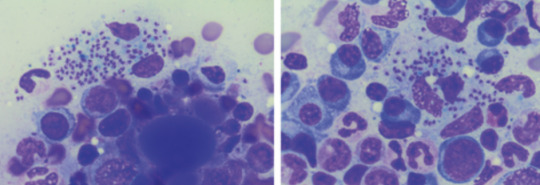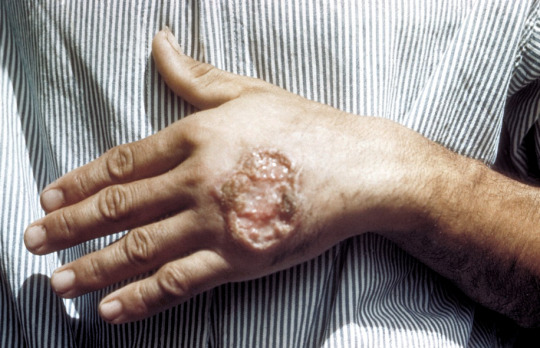#Leishmania
Explore tagged Tumblr posts
Text
Resistance to the main drugs used in Brazil against Leishmania is found in parasite infecting cutaneous leishmaniasis patient

Researchers in Brazil who analyzed samples from a 46-year-old patient in the Northeast state of Maranhão found an amphotericin B-resistant strain of the parasite Leishmania amazonensis circulating for the first time in the country. Amphotericin B is widely used to treat cutaneous leishmaniasis, a skin infection caused by sandfly bite.
The disease is characterized by skin lesions that persist for months but can be cured. In the case in question, however, the patient had the diffuse form of cutaneous leishmaniasis, which is rare, hard to treat, and associated with an inadequate immune response by the organism.
The patient also had HIV, which causes AIDS, making his condition even harder to combat. He had previously received treatments that were unsuccessful. The parasite was refractory to a therapeutic regimen involving the main drugs used against leishmaniasis in Brazil: meglumine antimoniate (preferred for several decades despite low efficacy) and amphotericin B (one of the few options available in Brazil for treating diffuse cutaneous leishmaniasis).
The researchers decided to find out how resistant the strain isolated from this patient was to amphotericin B by means of in vitro and in vivo trials. “We used mice infected by the isolated parasite for the in vivo model. We treated the mice with amphotericin B and two other drugs to which the patient had not been exposed: miltefosine and paromomycin,” says Adriano Cappellazzo Coelho, principal investigator for the study and a professor at the State University of Campinas’s Institute of Biology (IB-UNICAMP) in São Paulo state.
Continue reading.
#brazil#brazilian politics#politics#science#leishmania#image description in alt#mod nise da silveira
3 notes
·
View notes
Text

Leishmaniasis of the skin
2 notes
·
View notes
Text

TSRNOSS, p 693.
#calcium phosphate#malaria#potassium contnet of fruit#Leishmania#cytokinin#tocopherol#ascorbic acid#cortisol
0 notes
Text

"The infection is most common in parts of Africa, Brazil and the eastern Mediterranean region, like Iraq, Somalia, Sudan and Yemen, according to the World Health Organization. "
"All leishmaniasis infections are caused by Leishmania parasites but can have varying clinical presentations. The most common form – called cutaneous leishmaniasis – can cause ulcers and permanent scars. Some more severe variations of the disease can be fatal, according to the CDC."
source
#destiel meme#destiel meme news#united states#us news#news#not breaking news BUT something to be aware of#flesh eating parasite#texas#southern united states#tw parasite#it's only been seen in the us in cases of international travel#so it's kind of a big deal for it to just be here now#leishmaniasis#leishmania parasite
99 notes
·
View notes
Text
oh I’m going to throw up I hate tests so much
5 notes
·
View notes
Text
Question:
Asexual reproduction takes place through budding in :
(a) Amoeba (b) Yeast
(c) Plasmodium (d) Leishmania
Answer:
(b) Yeast
#Asexual reproduction takes place through budding in :#(a) Amoeba (b) Yeast#(c) Plasmodium (d) Leishmania
0 notes
Text

People say: adopt dont buy!!!!
The shelters: this is Mierdon, he has immunodeficiency and leishmania, and since he was abused the first 10 years of his Life and his dementhia, he cant be near kids nor eldery and needs to eat 7 times per day
#fav#ult fav#i love you sm mierdon#like my fav meme fr#animal shelter#mierdon#inmunodeficiencia y leishmania
0 notes
Text

The study involved genetically modifying malaria parasites to stop developing after a certain period of time in the human body. The modified parasites, named GA1 and GA2, were designed to prime the immune system without causing a full-blown malaria infection. Researchers then infected mosquitoes with these engineered parasites and allowed them to bite human test subjects in a controlled setting.https://rumble.com/embed/v23idi0/?pub=he97b
In the trial, 43 adults between the ages of 19 and 35 with no prior history of malaria infection were divided into three groups. The first group received 50 bites from mosquitoes infected with the GA2 parasite, the second group received 50 bites from mosquitoes infected with the GA1 parasite, and the third group, serving as a placebo, received 50 bites from uninfected mosquitoes. The participants underwent three vaccination sessions at 28-day intervals.
Three weeks after the final vaccination session, the human test subjects were exposed to malaria infection through bites from infected mosquitoes. The results showed that eight out of nine participants in the GA2 group were effectively protected against malaria, while only one out of eight in the GA1 group and none in the placebo group received protection.
The concept of using mosquitoes as “flying vaccinators” has been explored by scientists for years. In 2010, Japanese researcher Shigeto Yoshida modified mosquito saliva to deliver leishmania vaccines to mice, noting that vaccination by insect could be painless and cost-effective. However, concerns about informed consent and medical safety have hindered the development of this approach. That doesn’t appear to be a concern for Bill Gates and the professors he is funding today.
These fools are playing around with viruses capable of releasing a 75% mortality rate on the host population. These are intended to be used as weapons. These scientists seem to think an occasional breakout is worth the risk for creating an extremely lethal weapon. There is nothing sane about that.
39 notes
·
View notes
Text
Arch-Technocrat Bill Gates has made several investments over the years to fund research to develop insect vectors for vaccine delivery. Everybody says it won’t fly because informed consent is impossible, and yet the research continues unabated. These scientists have a death wish for humanity. ⁃ Patrick Wood, Editor.
Researchers at the Bill Gates Foundation-backed Leiden University Medical Center in the Netherlands have joined an international effort to transform mosquitoes into flying syringes. According to a study published late last month in the New England Journal of Medicine, they apparently now have an effective way of using mosquitoes to deliver some protection against malaria in unsuspecting humans — and possibly other payloads in the future as well.
Scientists have long toyed with the idea of transforming mosquitoes into “flying vaccinator[s].”
Shigeto Yoshida, the lead researcher on a 2010 study that modified mosquitoes’ saliva such that they would deliver leishmania vaccines to mice when sucking their blood, noted that vaccination by insect was “just like a conventional vaccination but with no pain and no cost.”
“What’s more, continuous exposure to bites will maintain high levels of protective immunity, through natural boosting, for a lifetime. So the insect shifts from being a pest to being beneficial,” added Yoshida.
Despite the Japanese geneticist’s optimism, his study acknowledged that “medical safety issues and concerns about informed consent mitigate the use of the ‘flying vaccinator’ as a method to deliver vaccines.”
Robert Sinden, professor emeritus of parasite cell biology at Imperial College London, told Science at the time that in addition to vaccinating people without their informed consent, no regulatory agency would sign off on the initiative.
The issue of informed consent, apparently an ongoing issue for elements of the scientific community, was evidently not enough to hinder the continued development of flying vaccinators. Hiroyuki Matsuoka of Jichi Medical University in Japan, for instance, announced that with the help of a 2008 Gates Foundation grant, he was preparing work on an engineered mosquito that could produce and secrete a malaria vaccine protein into a host’s skin.
In 2022, Sean Murphy and his team at the University of Washington demonstrated the workability of that idea, testing mosquito-borne malaria vaccines on humans, establishing what they called a “proof of concept” for the technology.
Concerned about the short-lived and marginally effective nature of the malaria vaccines currently approved by the World Health Organization, Dutch researchers at the LUMC similarly turned to genetically modified parasites and mosquito carriers as a potential alternative.
In an earlier trial, the researchers tested the effectiveness of GA1, a malaria parasite genetically modified to stop developing after roughly 24 hours of infection in humans, but found that it only provided low protective efficacy against malaria. Hoping for a better outcome, the researchers crafted another parasite, GA2, to stop developing around six days following invasion in preclinical humanized mouse models.
The Bill Gates-backed Gavi, also known as the Vaccine Alliance, noted that “because the parasite dies before it infects the blood cells and evolves into its deadly phase, it instead acts as a way of priming the immune system, as a vaccination usually would.”
9 notes
·
View notes
Text

I suspected Trypanosoma and Leishmania were connected because they have the same lifecycle #58secondobservation #smart
7 notes
·
View notes
Text
"REMINDER: [Day 110 of the ongoing and now accelerating genocide] Israel is still killing 200-300 civilians daily in Gaza (half of them children) and injures twice as many daily. People injured have very little medical care and die regularly of infested wounds or get their limbs amputated with kitchen knives without anesthesia (1100 children had their limbs amputated as such). Casualties (injured and killed) are now 3.2% of the 2.3 million population (equivalent to 11.2 million US victims). Israel continues to deny humanitarian aid (food, water medicines including anesthesia) with Egypt's collusion. Famine is spreading especially among the 400-500,000 civilians left in North Gaza (but also in other regions of Gaza). Deaths are thus accelerating. Diseases (Hepatitis A, Leishmania, intestinal and skin disorders) are spreading with no treatments. Israel rendered most of the hospitals and clinics inoperational. Kidney dialysis patients, cancer patients, and other patients are dying as there are no treatments. Winter storm arrived today and 1.9 million people have no shelter. 110 journalists were killed and over 250 injured. This is about 15-20% of all Journalists in Gaza, higher than population rate so it is intentional targeting to suppress truth coming out. Israeli occupation forces also killed of academics and doctors and destroyed hundreds of mosques, 3 churches, six cemeteries, universities and hospitals. The intention is to reduce Gaza strip to rubble (70% of all building are already damaged). We will not forgive or forget the complicity many and silence of many people. We are grateful to those who act." ~ Mazin Qumsiyeh, 1/23/34
#thought i'd share an update from his newsletter since he wrote it so succinctly#the rate of journalist murders really fucking struck me#free palestine#palestine#free gaza#gaza
24 notes
·
View notes
Text
Leishmaniasis
Case Reports, like we're on a episode of house

23M in Kenya, presenting with months of LOW, persistent fevers, and abdo fullness, found to have massive splenomegaly.
examination: massive splenomegaly (10 cm below costophrenic margin, and will definitely cross midline) and hepatomegaly
pancytopaenic on bloods, plt's down to 40s
diagnosis confirmed on BMAT (parasite seen)
normal HIV, liver and kidney function
Bodies seen on the BMAT below are part of the lifecycle of the parasite that is intracellular, hence you can see the macrophages/neutrophils loaded with them, even bursting

What is it:
think of it when you get a patient with pancytopaenia and hepatosplenomegaly, who either traveled to or is in/from a tropical/subtropic region (where sand flies are)
cause - protozoa parasite Leishmania, transmitted by infected sandflies
Epidemio (when to consider it)
tropics, subtropics (South America, Asia, AFrica), Southern Europe
Microbiology/Transmission
parasite, replicates intracellularly (Leishmania donovani)
transmitted in sand flies (can be unnoticeable and usually bite in dawn or dusk - evenings or night), can also be transmitted via needles/blood
more common in rural areas
I've simplified this, but is more extensively covered in StatPearls and Wiki (there's different species of Leish and sandflies that transmit it)
once bitten, the protozoa are phagocystosed by skin macrophages, which then becomes full of the "bodies" (part of the lifecycle). Eventually these burst to release more of the bodies that infect more macrophages
they eventually are spread via blood to liver/spleen/BM and LNs
Random history:
ancient, records of disease date back to Egyptian mummies from 3000 BC --> positive DNA amplication for Leishmania and on papyrus from 1500 BC

multiple physicians from different times have described the disease, but it's named for 2 who described the parasite's intracellular ovoid body stage in smears from infected patients in India: Lt General William Boog Leishman and Captain Charles Donovan (Ronald Ross named the bodies after the 2 --> "Leishman Donovan bodies"
significant disease in Allied troops in Sicily in WWII, called "jericho buttons" (image on wiki from a WWI trooper serving in the middle east)

Leishman: Scottish pathologist and British Army medical officer, later it's director general in the 20s, did extensive research into the parasite named for him by Sir Ronald Ross. He mistook the parasite he observed for trypanosomes (cause of Chagas in South America and African sleeping sickness in Africa)
Donovan: Irish parasitologist, medical officer in India, observed an epidemic across India just after the rebellion of 1857, discovered the "bodies" in spleen tissue as the causative agent for what the locals called "kala azar" (severe visceral leishmaniasis - see below)
Donovan also discovered the "bodies" of Klebsiella granulomatis, hence these too are named after him (cause of ulcerative granulomas)
It became scandalous as both wanted credit for the "discovery" of this newly identified organism. So Sir Ronald Ross named it for both of them.
Sir Ron, by the way, won a Nobel in Medicine for discovering that malaria is transmitted via mossies (this was also a source of scandal, he was meant to share it with another physician who he accused of fraud - and they never received the award)
finally, it was actually a Russian physician who identified it first, but well, he published in a little known Russian journal which was promptly forgotten.
Clinical features
cutaneous type vs visceral organ type (spleen, liver, bones)
From wiki

can be asymptomatic
cutnaeous: can be there for years and resemble leprosy, causes an open chronic wound (most common), incubation 2-4 weeks on average (nodules at site of inoculation that eventually form ulcers), can heal spontaneously in 2-5 yrs
in diffuse cutaneous cases, can affect face, ears, extensor surfaces
can be muscosal = eg nasal symptoms/epistaxis, severe: perforated septum, this occurs in 1/3 after resolution of cutaenous symptoms (can be severe/lifte threatning, as it can affect vocal cords and cartilage, but oddly not bone)
visceral (incubation periods of up to years until immuncompromise): fever, weight loss, hepatosplenomegaly (spleen more than liver), pancytoaepnia, high total protein and low albumin with hypergammaglobulinaemia
this has seasonal peaks related to sandfly habits and humidity
interestingly it is an infective cause of massive splenomegaly, such that it crosses the midline
Extreme - but noticeable hepatosplenomgealy/abdo fullness, from medscape

can be atypical in HIV co infected patients, LAD in seom regions like Africa
Kala azar = black fever in some severe cases (fatal due to secondary mycobacterial infection or bleeding), refers to damage fto spleen, liver and anaemia
invstigations:
serology not great (minimal humoral response to the parasite), so often requires histopath (tissue sample) for which BMAT is safest in visceral organ involvement
visualisation of amastigotes (or Leishman-Donovan bodies), as intracellular --> can be seen in macrophages (small round bodies) post Giemsa staining
PCR of DNA also possible (as done in the Egyptian mummies)
Image source:

Treatment

liposomal amphotericin B (holy shit strong stuff) in visceral, PO: miltefosine (caution in pregnancy), all have significant ADRs, or paromycin. however, mortality of 10% if visceral left untreated
mixed results with azoles
in HIV co infection - start the HAARTs! can improve survival, mortality is 30% in HIV patients
cutaneous: stibolgluconate (have never heard of these drugs) and megluaine antimoniate, but limited disease often spotnaeously gets cleared by the innate system
prevention:
use DEET insect repellant at dawn and dusk
loose fitting clothing that covers all skin
no vaccine (were attempts at vaccinating dogs, which decreased rates)
sandflies are smaller than mossies, so requires small netting

Differentials for hepatosplenomegaly

Sources:
WHO guidelines
CDC guidlelines
Wiki - Haven't covered pathophysio, but wiki does extensively
StatPearls
DermNet - great resource for all things derm, that my derm colleagues pointed out to me
9 notes
·
View notes
Text
IL BANGLADESH È IL PRIMO PAESE A DEBELLARE LA LEISHMANIOSI

Il Bangladesh è diventato il primo Paese al mondo ad essere ufficialmente libero dalla leishmaniosi viscerale, malattia comunemente nota come kala-azar.
Nel 2005, Bangladesh, India e Nepal (che insieme rappresentavano il 70% del carico globale della malattia) hanno lanciato un’iniziativa per l’eliminazione del kala-azar. Questi sforzi sono stati accompagnati da un quadro strategico regionale incentrato sulla diagnosi precoce, la gestione completa dei casi, la gestione integrata dei vettori, la sorveglianza della malattia, la mobilitazione sociale e la ricerca operativa.
Kala-azar, la forma più grave di leishmaniosi, è una malattia mortale causata dalla Leishmania un parassita trasmesso attraverso la puntura di insetti infetti che colpisce prevalentemente le comunità rurali più fragili. Nel corso degli anni, gli sforzi di ricerca e sviluppo, coordinati dall’OMS, insieme ad altri partner tra cui il governo del Regno Unito e la Fondazione Bill & Melinda Gates, hanno portato all’introduzione di strumenti come il test immunocromatografico rapido rK39 e terapie come la miltefosina che hanno svolto un ruolo fondamentale nel consentire la diagnosi precoce e il trattamento nelle comunità remote. “Il Bangladesh è il primo Paese ad eliminare due malattie tropicali trascurate nello stesso anno, dopo aver convalidato con successo l’eliminazione della filariosi linfatica come problema di salute pubblica nel maggio 2023”, ha osservato Ibrahima Socé Fall, direttore del Programma globale sulle malattie tropicali trascurate dell’OMS.
Ad oggi, 50 paesi hanno eliminato almeno una malattia tropicale trascurata, in linea con l’obiettivo della road map dell’OMS di far sì che 100 paesi raggiungano questo traguardo entro il 2030.
___________________
Fonte: Organizzazione Mondiale della Sanità; foto di Kelly

VERIFICATO ALLA FONTE | Guarda il protocollo di Fact checking delle notizie di Mezzopieno
BUONE NOTIZIE CAMBIANO IL MONDO | Firma la petizione per avere più informazione positiva in giornali e telegiornali

Se trovi utile il nostro lavoro e credi nel principio del giornalismo costruttivo non-profit | sostieni Mezzopieno
13 notes
·
View notes
Text
He's mierdón. He has immunodeficiency and leishmania. Because of being abused over the first 10 years of his life and his dementia he can't be around children nor old people and he needs to eat 7 times a day.
@iroissleepdeprived
5 notes
·
View notes
Text
The use in science of common words for specialized meanings, or conversely for bastardized versions of scientific terms to enter common speech, are so common (witness the highly specific meaning of "impulse" or "flavor" in physics, the vulgar use of "energy", "evolution", or "quantum", the use of "life" and "death" for inanimate objects such as stars, or my own pet peeve, the use of "exponential" to mean that a number is bigger than another number) that one may be surprised to realize that "being related" means in evolutionary biology exactly the same thing it means in common speech.
When we say "whales are related to hippopotami", no metaphor or specialize meaning is involved: the word "related" has exactly the same meaning as when I say "I am related to my cousin".
Simulations suggest that, thanks to population mixing, the most recent common ancestor of all (currently living) humans lived between 2000 and 5000 years ago. That means that any living human being is at most a 200th cousin of any other, even if one is an Inuit and the other a Samoan. In the same sense, any human is approximately...
350,000th cousin of a chimpanzee; 1.6 millionth cousin of a baboon; 7.5 millionth cousin of a lemur; 40 millionth cousin of a mouse; 50 millionth cousin of a dog, or a whale, or a bat; 90 millionth cousin of a kangaroo; 250 millionth cousin of a bird or a lizard; 370 millionth cousin of a bony fish; 470 millionth cousin of a lamprey or hagfish; 800 millionth cousin of a starfish; 1.3 billionth cousin of a housefly or an earthworm or an octopus; 3.3 billionth cousin of a sponge; 1 trillionth cousin of a mushroom or an amoeba; 1.4 trillionth cousin of a pine tree or a blade of grass; 3.2 trillionth cousin of Leishmania and Trypanosoma; and perhaps 6 trillionth cousin of bacteria.
(calculations based on the assumption that average generation time is 25 years for modern humans, 15 years for other apes, 5 years for other primates, 1 year for earlier vertebrates, 30 days for an earlier invertebrate, and 4 hours for a unicellular organism)
18 notes
·
View notes